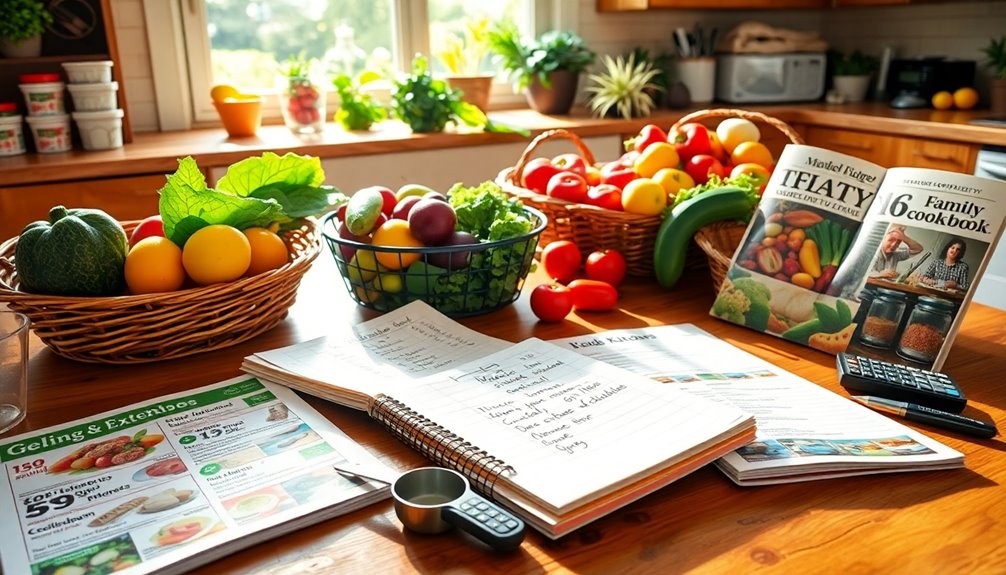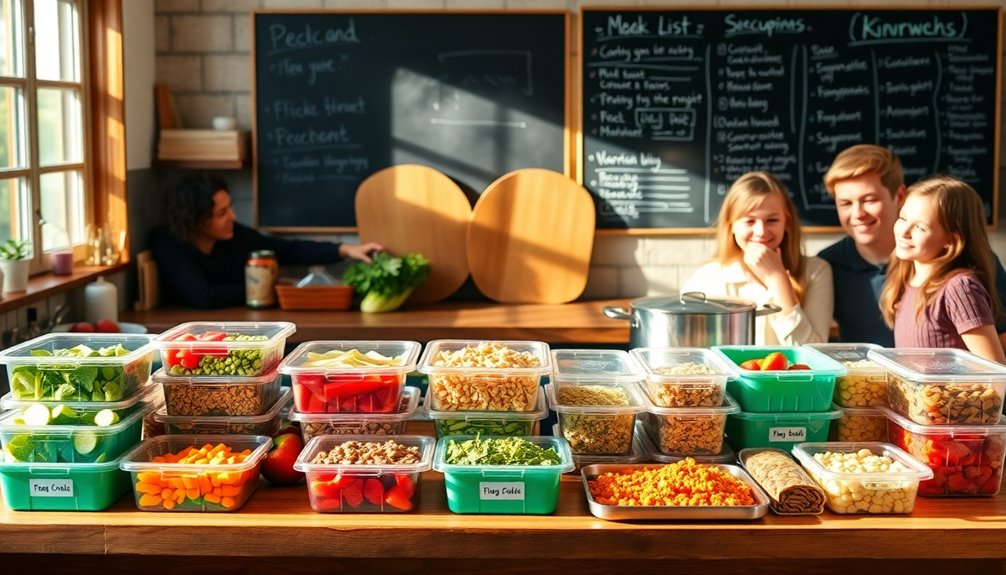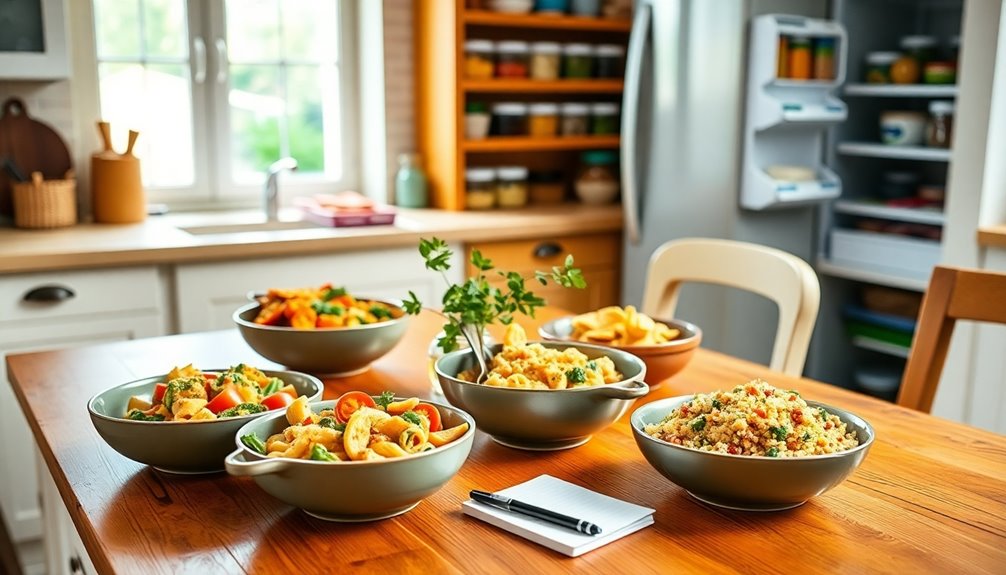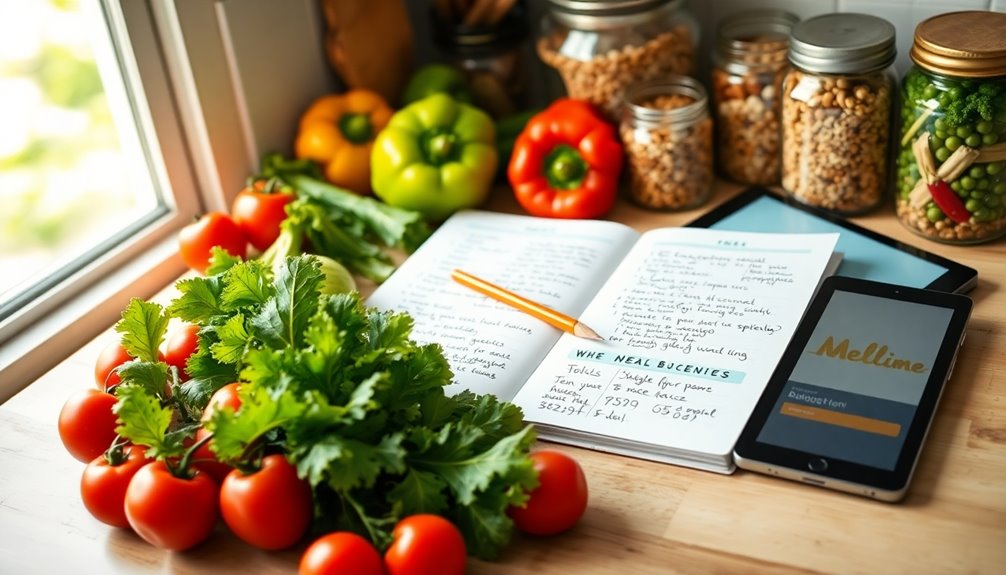You can easily save money and time by planning meals that cater to your family's needs. Start by involving everyone in meal planning—this helps identify favorite meals and dietary restrictions. Plan your meals around sales, focusing on seasonal produce to stretch your budget. Batch cooking can save time and reduce waste, while transforming leftovers into new dishes keeps things interesting. Make sure to create a shopping list and stick to it, avoiding impulse buys. Finally, consider community resources like food pantries or local cooking workshops for additional budget-friendly options. There's much more to explore beyond these strategies!
Key Takeaways
- Involve the whole family in meal planning to cater to dietary preferences and share favorite recipes, creating a sense of ownership and excitement.
- Plan meals around sales and seasonal produce to maximize savings and ensure fresh ingredients without breaking the budget.
- Batch cook meals and freeze leftovers in labeled containers to save time and reduce food waste, while ensuring variety in your weekly menu.
- Use versatile ingredients like rice, beans, and seasonal vegetables to create cost-effective meals that can be mixed and matched throughout the week.
- Pack lunches for work and school, and explore community resources like food pantries and gardens for fresh, budget-friendly produce options.
Assess Your Family's Needs

Assessing your family's needs is essential for effective meal planning. You'll want to ponder everyone's preferences and requirements, which can make planning less stressful and more enjoyable. Start by identifying any dietary restrictions that family members may have. Whether it's allergies, intolerances, or specific diets like vegetarian or gluten-free, understanding these needs will help you create meals that everyone can enjoy safely.
Next, take a moment to evaluate the eating habits of your family members, especially if you have picky eaters in the house. These individuals may be more selective about what they eat, so knowing their likes and dislikes can save you from the frustration of preparing meals that go untouched.
Encourage open discussions about food preferences, and contemplate involving your family in the planning process. This not only fosters a sense of belonging but also helps your picky eaters feel more invested in what they're eating.
Once you've gathered this information, create a list of meals that accommodate everyone's needs. Aim for a variety of flavors and textures to keep things interesting. You might find that certain ingredients can be used in multiple ways to cater to different tastes, allowing for flexibility while still addressing dietary restrictions. Additionally, incorporating plant-based ingredients can provide numerous health benefits while making meals more appealing to the whole family.
Plan Meals Around Sales

Often, planning meals around sales can greatly reduce your grocery bills while still allowing for nutritious and delicious options. By keeping an eye on grocery discounts, you can stretch your budget further and make healthier choices for your family. Start by checking weekly ads from your local grocery stores—this will help you identify which items are on sale and plan your meals accordingly.
One effective strategy is to focus on seasonal produce. Fruits and vegetables in season not only taste better but are often cheaper due to their abundance. For instance, if strawberries are on sale, consider making a fresh salad featuring them or blending them into smoothies.
Similarly, if squash or zucchini is discounted, you could whip up a hearty vegetable stir-fry or bake a comforting casserole.
When you plan your meals based on what's on sale, you're more likely to try new recipes and ingredients. This not only keeps your meals interesting but also encourages your family to explore different cuisines. Plus, buying in bulk during sales can save you even more money in the long run, especially for pantry staples like rice, beans, and pasta.
Lastly, don't forget to create a flexible meal plan. If you see a great deal on meat or dairy, adjust your weekly menu to incorporate those items. By aligning your meal planning with grocery discounts and seasonal produce, you're not only saving money but also fostering a healthier eating environment for your family. Implementing natural calorie cycles can also help in maintaining a balanced diet while managing your grocery expenses effectively.
Involve the Whole Family

Getting the whole family involved in meal planning not only makes the process more enjoyable but also fosters teamwork and creativity. When everyone contributes, it creates a sense of ownership and belonging, which can lead to healthier eating habits. Start by holding a family meeting where each member can share their favorite meals or ingredients. This way, everyone feels heard and valued.
Next, assign roles based on age and ability. Younger kids can help with simple tasks like washing vegetables or measuring ingredients, while older children can assist with meal prep, like chopping or cooking. This not only teaches valuable cooking skills but also encourages family involvement in a fun way.
You can also create a rotating meal calendar, where each family member picks a meal for the week. This method helps diversify your menu while ensuring everyone's tastes are considered. It's an excellent opportunity to introduce new recipes that align with your family's preferences.
When it comes to grocery shopping, involve the whole family by making it a fun outing. Let them help choose fresh produce or healthy snacks, which can enhance their excitement about the meals to come. Additionally, incorporating easy-to-follow recipes can make cooking more accessible for everyone.
Lastly, don't forget to celebrate your cooking efforts. Share the meals you've prepared together, and discuss what everyone enjoyed about the process. This reinforces the idea that meal prep isn't just about food; it's about bringing the family together and creating lasting memories.
Batch Cooking and Freezing

Since life can get hectic, batch cooking and freezing meals can be a game-changer for busy families. This time-saving technique allows you to prepare large quantities of food in one go, ensuring you always have nutritious meals on hand.
Imagine coming home after a long day and finding a homemade lasagna or a hearty chili waiting for you in the freezer. It's a relief!
To get started, choose recipes that lend themselves well to freezing. Soups, stews, casseroles, and pasta dishes are all great options. As you plan your meals, think about flavorful combinations that your family loves.
For example, mixing beans, veggies, and spices can create a delicious chili that freezes beautifully. You can even double or triple your recipes to maximize efficiency.
When it comes to freezing, use airtight containers or freezer bags to keep your meals fresh. Label each container with the date and contents, so you can easily pick out what you want later. Remember to leave some space in the container since liquids expand when frozen.
Batch cooking not only saves time but also cuts down on meal prep stress throughout the week. You'll find yourself spending less time in the kitchen and more time enjoying family meals together. Plus, it helps you stick to your budget by reducing the temptation to order takeout on busy nights. Additionally, maintaining a balanced diet through meal planning can be beneficial for managing underlying conditions that may contribute to health issues like CKD.
Embrace batch cooking and watch how it transforms your dinner routine!
Utilize Leftovers Creatively

Transforming leftovers into new meals can be both fun and economical for families. By utilizing creative leftover recipes, you can minimize food waste while also saving money. Start by considering your leftover ingredients as building blocks for new dishes.
For example, if you have an excess of roasted chicken, think about using it in tacos, salads, or stir-fries. This approach not only simplifies meal prep but also keeps your family excited about dinner.
Meal prep strategies are crucial for maximizing your leftovers. Dedicate one day a week to evaluate what you have in your fridge. Arrange your leftover ingredients and brainstorm new recipes that integrate them.
You might discover that leftover vegetables from a stir-fry can easily evolve into a hearty soup or a tasty frittata.
Additionally, think about batch cooking staples like grains, legumes, or sauces that can act as a foundation for multiple meals throughout the week. This way, you can mix and match with leftovers, adding variety without incurring extra expenses.
Lastly, involve your family in the process. Encourage everyone to contribute ideas or even assist in the kitchen. This not only nurtures a sense of belonging but also makes mealtime a collaborative experience. Moreover, properly activated glutes can enhance movement efficiency, which is beneficial for busy families managing meal prep and cooking together.
Frequently Asked Questions
How Can I Find Recipes That Fit My Family's Dietary Restrictions?
To find recipes that fit your family's dietary restrictions, start by searching for allergy-friendly options online.
You can use websites or apps that allow you to filter recipes based on specific ingredients.
Don't hesitate to explore ingredient substitutions; many common allergens have safe alternatives.
Joining online communities can also help you connect with others facing similar challenges, sharing ideas and recipes that work for everyone in your household.
What Are Some Affordable Grocery Stores to Consider for Meal Planning?
Imagine a treasure hunt where the prize is nourishing meals for your family. Start at discount stores like Aldi or Lidl, where you'll find affordable staples.
Don't forget farmer's markets—fresh produce often comes cheaper and supports local farmers.
Online resources and community cookbooks are goldmines for recipes using seasonal ingredients. By exploring these options, you not only save money but also connect with your community, sharing delicious meals and experiences.
How Do I Ensure Variety in Meals Without Overspending?
To guarantee variety in your meals without overspending, focus on meal prep and food rotation. Plan a weekly menu that incorporates different proteins, grains, and veggies. By preparing larger batches and rotating your ingredients, you can create diverse meals while minimizing waste.
Experiment with different spices and cooking methods to keep things interesting. This approach not only saves you money but also makes mealtime enjoyable for everyone in your household.
What Kitchen Tools Can Help Make Meal Prep Easier and Cheaper?
To make meal prep easier and cheaper, consider investing in a food processor and a slow cooker. A food processor speeds up chopping and slicing, letting you prepare ingredients quickly.
A slow cooker allows you to set it and forget it, saving you time and effort. These tools help you create a variety of meals with minimal fuss, ensuring you enjoy cooking without breaking the bank. Embrace these tools and simplify your kitchen experience!
Are There Apps That Assist With Budget Meal Planning for Families?
Imagine a treasure map leading to delicious, budget-friendly recipes. Meal planning apps are your compass, guiding you through the grocery aisles without breaking the bank. These apps help you discover affordable ingredients, create shopping lists, and even suggest budget-friendly recipes tailored to your family's tastes. By using them, you'll not only save money but also foster a sense of togetherness as you plan and prepare meals that everyone can enjoy.
Conclusion
In the garden of family life, nurturing your budget can yield a bountiful harvest. By evaluating needs, planning around sales, and involving everyone, you'll cultivate a thriving meal plan. Batch cooking and creatively using leftovers are like tending to your crops, ensuring nothing goes to waste. As you embrace these tips, you'll not only save money but also create delicious memories together, transforming mealtime into a feast of connection and joy. Let your family garden flourish!



